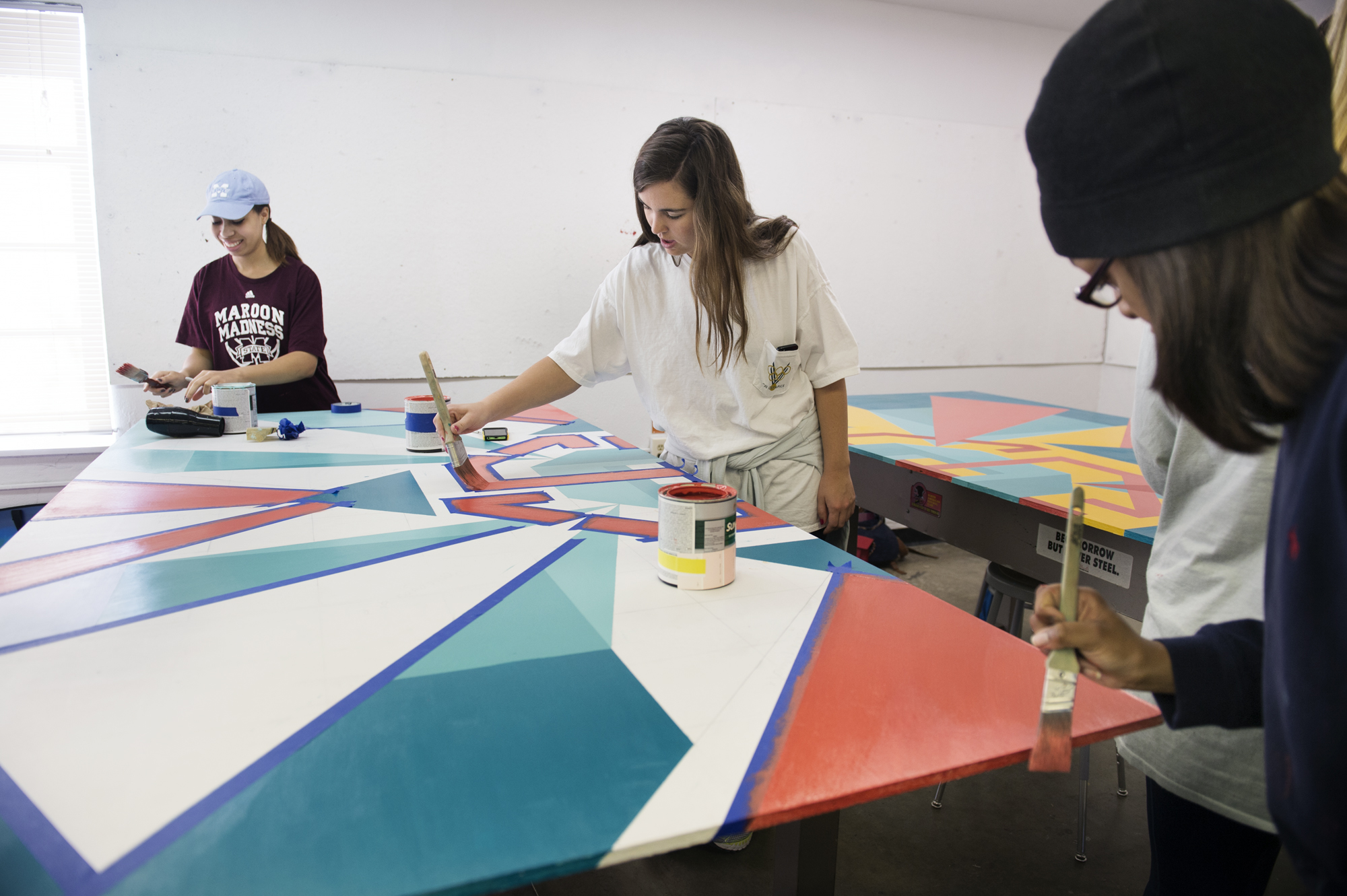Contact: Allison Matthews

Photo by: Megan Bean
STARKVILLE, Miss.--A community project by students in a Mississippi State art class may have a lasting local impact as part of a national Barn Quilt Trail program.
Barn quilts began several years ago in Ohio and quickly became a trend that spread across the United States. Typically, an eight-by-eight-foot wooden square is painted to resemble a quilt block and positioned at the front of a barn or other structure.
With a goal to put Mississippi on the national Barn Quilt "map," members of the Starkville Area Arts Council became interested in the project for Oktibbeha County.
The organization was aided by the university's Center for the Advancement of Service-Learning Excellence--CASLE, for short--that works to identify and develop ways to incorporate service-learning projects into course curricula.
When complete, the finished works will be installed at such locations such as the Oktibbeha County Heritage Museum, Starkville Community Market, Habitat for Humanity warehouse, and a local park, as well as the MSU Horse Park.
A website managed by Suzi Parron, author of "Barn Quilts and the American Quilt Trail Movement," shows Oktibbeha and Greene counties as the first in Mississippi to participate in the national trail. See www.barnquiltinfo.com for more.
April Heiselt, CASLE director, said service-learning is a holistic approach to instruction that integrates meaningful community service and civic engagement into academic objectives. Using experiential learning and critical reflection, it is designed to enrich educational experiences, teach civic responsibility and meet the needs of communities, the associate professor of counseling and educational psychology added.
SAAC member Vicki Burnett, Oktibbeha County Quilt Trail co-chair, brought the idea to Heiselt who, in turn, contacted MSU art department faculty.
Jamie Mixon, interim department head, and Neil Callander, assistant professor, thought the project would fit well with a design course.
Heiselt said, "Neil already used quilts to teach color block theory. I don't think I could have developed a class that could have been a more perfect match for this particular service-learning project."
Also taking part was assistant professor Suzanne Powney, who included the project in her graphic design course.
Callander's students, primarily art and graphic design majors, were studying color palettes and color interactivity. He said they first worked individually to create a full-color Barn Quilt design influenced by research about the traditional quilt-making folk art and other color theory topics.
Next, they formed teams to collaborate on the design and creation of the eight-foot-square quilts.
Ava Moore, the other Oktibbeha County Quilt Trail co-chair, and Burnett are helping coordinate with other local groups and individuals to create additional barn quilts. Plans include placements at the Sam Hamilton Noxubee National Wildlife Refuge, Oktoc Community Center and adjacent Oktoc Fire Station, and on some private barns.
Burnett, a painter, said her own family is creating one for the art studio by her Sunnyland Estates home. Formerly a Leake County 1940s-era country store, the studio was moved from its original location.
"I think there's a lot of value in taking the art of quilting beyond the home to appreciate this traditional art in a new way," said the owner of Burnett Art, Cowbells and Calligraphy. "So many community members and entities are coming together to make our community more aesthetically pleasing."
Callander said service-learning projects like this provide excellent venues for students to apply academics to real-world situations.
Freshman Kelli M. Clayton of Pass Christian, a double-major in drawing and design, agreed, saying she enjoyed creating a small quilt design and seeing it through to creation on a much larger scale.
As part of her research, she studied aesthetic qualities inherent to the local area. "I also researched Choctaw Indians and found that they revered the sun and eagles. We've incorporated eagle feathers into our design," she said.
Clayton called the project "very rewarding because, not only are you learning, you're helping the community."
While this time it was art courses, CASLE also has facilitated service-learning projects in the colleges of Business, Education and Bagley College of Engineering. For more, visit http://servicelearning.msstate.edu.
For more information about Mississippi State University, see www.msstate.edu.